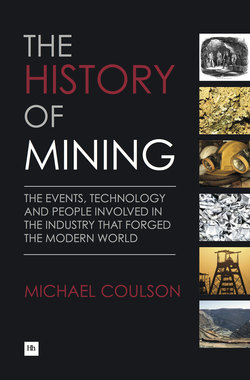Читать книгу The History of Mining - Michael Coulson - Страница 31
На сайте Литреса книга снята с продажи.
Оглавление15. Conclusion
In the 21st century things move very fast; technological advances can be rendered obsolete even before they have achieved widespread use and science seems to have replaced religion as the fountain of truth. In other words our world is completely different from the one that our ancient ancestors lived in.
It is therefore not surprising how slowly things changed all those millennia ago and that the world of mining mirrored that slow pace of change. A number of mining techniques persisted for centuries, passing from Stone to Bronze to Iron Age. The practice of fire setting remained a widely used method of breaking mineralised rock, particularly underground, across these periods. Stone hammers, which were used to break and crush smaller pieces of rock, survived the Stone Age, and treatment of crushed ores was consistently done in open, and later enclosed, furnaces and in some cases crucibles, the fuel to fire these furnaces being charcoal. Some of the treatment techniques even survived into the modern era – hydraulic mining known to the Romans was rediscovered in the 19th century AD and the use of stored water to wash ore was another early development that survives even today.
Mining methods also continued basically unchanged throughout the ancient period. Pits were scoured out and shafts were painstakingly dug using basic tools of stone and then iron. Underground tunnels were driven, galleries dug out and wooden open drains to control water inflows were laid down.
The products that metals were used to make also hardly changed in seven millennia. Basically man needed weapons, protective metal products such as armour a little later, cooking and kitchen utensils (although clay/ceramic items were also used), tools, jewellery and, in the case of gold and silver, money.
As an example of this slow pace of development, we can look at the working of wood which, along with stone, was the most important construction material from the Stone Age to the Middle Ages. For 4000 years until the Bronze Age wood was cut using jagged flint tools; in the next 2000 or so years a hand-sawing blade made of metal emerged. With the coming of iron, saws began to cut stone as well as wood. As the age of the Industrial Revolution dawned the technology of woodcutting – exploiting water and then electrical power – began to change and improve. The speed of this technological change also accelerated as new metal compounds were discovered improving operating efficiency and productivity. Saws were also developed that cut metal as well as wood.
It is also the case in a world where life was often ‘nasty, brutish and short’ – and one might add also extremely unhealthy – that population growth was glacially slow, so that annual output from individual mines was correspondingly modest, allowing some metal deposits to last for centuries. Indeed, over the period of the Ancient World (roughly 6000 BC to 1000 AD), world population is thought by the US Census Bureau to have risen from 10 million to 300 million, roughly the same increase numerically that the World experienced in the three years from 2005 to 2008.
Mining conditions remained dangerous throughout this period – there was little incentive to improve things as it was common to use an expendable slave workforce in mines and quarries; indeed mining conditions probably only began to improve significantly in the 20th century AD.
A virtually unchanged industry
This picture of an industry operating in a virtually unchanged manner for so long, supplying metal for the manufacture of products which also remained unchanged over centuries, mirrors the limited technological advances made during prehistory. Of course the rise of the Assyrian Empire and the period of Roman supremacy, which followed it, did lead to considerable technological developments but these were in large part lost when the Roman Empire crumbled and Europe in particular entered the Dark Ages. Apart from the Romans, the most advanced region or nation, particularly in the later stages of antiquity around the 10th century AD, was China, but its great technical inventions such as the compass and paper were not metal critical.
Having said that, the achievements of the Romans must have led some thinkers then to ponder whether they could take Roman advances further. The work of the Greek mathematician Hero of Alexandria in the 1st century AD – with his rotating cylinder or aeolipile powered by steam from a furnace connected to the cylinder – was the first steam engine and pre-dated Stephenson by almost two millennia. If the Romans had built on that who knows where technology and therefore metal demand might have got to, and a whole lot else indeed.
Certainly in the next period we will look at, the Middle Ages, the Florentine genius Leonardo da Vinci, showing the same sort of foresight, sketched out numerous futuristic developments including the aeroplane.
